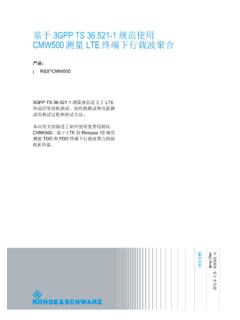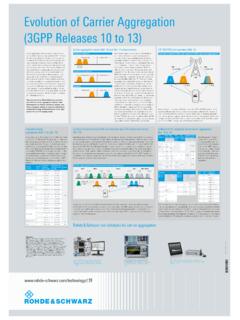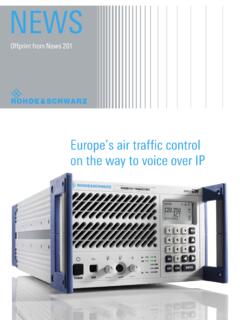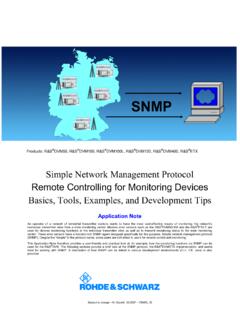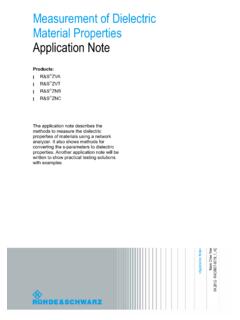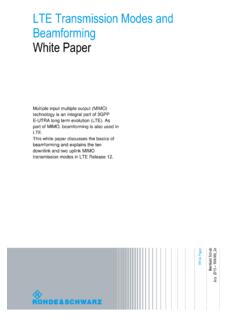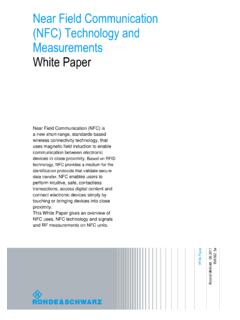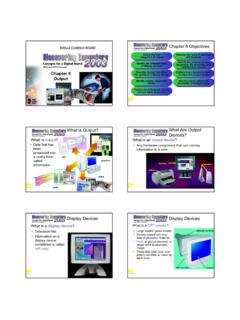Transcription of Eye Measurements on HDMI signals - Rohde & Schwarz
1 Eye Measurements on hdmi signals with the R&S VT-B2380. TMDS time domain analyzer The high-definition multimedia interface ( hdmi ) standard is the leading standard for the transmission of uncompressed video data within the home. To ensure that all devices using this interface work together seamlessly, the hdmi Forum has defined and compiled a series of tests in a Compliance Test Specification (CTS). These include protocol tests as well as tests of the electrical parameters for an hdmi interface. Because of the technology used for hdmi and the associated high data rates, these tests require complex and cost-intensive T&M equipment. This paper describes an efficient alternative in the form of a sampling oscilloscope. It covers the fundamental principle behind electrical testing of hdmi sources, such as those found in set-top boxes, Blue-ray players, cameras, PCs and smartphones. It additionally discusses the differences as compared to the conventional time-domain analysis methods.
2 Please find the most up-to-date document on our homepage http:\\ . - White Paper Table of Contents Table of Contents 1 Introduction .. 3. Serial data transmission in accordance with the hdmi Compliance tests ..4. 2 Principle behind the data eye diagram measurement .. 5. Subsampling ..5. R&S VT-B2380 TMDS time domain analyzer ..7. R&S VT-B2380 TMDS clock jitter measurement ..9. 3 Examples .. 10. Eye 4 Conclusion .. 12. A Automated Measurements on the VT-B2380 time domain analyzer ..13. Rohde & Schwarz Eye Measurements on hdmi signals 2. Introduction Serial data transmission in accordance with the hdmi standard 1 Introduction hdmi is a wired transmission standard for uncompressed video signals between consumer home electronics equipment. Uncompressed video requires a high data rate. For example, an hdtv picture displays 1920 * 1080 = 2 073 600 pixels, with each pixel consisting of 3 color values (red, green and blue) with 8-bit quantization.
3 For historical reasons, a synchronization frame with free data ranges ( for audio) is added along with additional bits for transmission coding. An increase in the quantization ("deep color") is also possible, which naturally requires an increase in the data rate. In total, hdmi transmission requires a data rate range of 3 * 250 Mbit/s up to 3 * Gbit/s for all conventional aspect ratios and refresh rates. This range is specified by hdmi For UHDTV (4k) with refresh rates of 50 Hz or 60 Hz, the data rate was extended in hdmi to 3 * The factor 3 is used here because hdmi is equipped with 3 data lines. Serial data transmission in accordance with the hdmi . standard Data on hdmi cables is transmitted serially on one wire pair using current mode logic. In other words, the transmitter contains a current sink that is switched so that it is out of phase with one or the other wire, depending on the logic information. The receiver terminates the wires with 50 ohm to + volt and uses a differential amplifier to access the logic information.
4 The spectrum of the hdmi data signal corresponds to that of digital NRZ signals and is made up primarily of signal components up to the bit rate and additional components up to 2 and 3 times the bit rate. For signal analysis at Gbit/s, this translates into a required measurement bandwidth of up to 18 GHz. Fig. 1: Spectrum for a 6G TMDS in line with hdmi 1 UHDTV (4k) with lower refresh rates and reduced color range is also possible with hdmi Rohde & Schwarz Eye Measurements on hdmi signals 3. Introduction Compliance tests These high bandwidth requirements apply not only to the test instrument, but also to the plug connector and the cabling to the test instrument. Compliance tests To ensure connectivity of devices from a wide variety of manufacturers, the hdmi . Forum has prepared the Compliance Test Specification (CTS). This specification assists in assessing the characteristics of hdmi components or consumer electronics equipment. Manufacturers are authorized to use the hdmi logo for devices that pass these tests.
5 A portion of the tests is based on the electrical characteristics of hdmi . signal sources. This document specifically addresses these electrical tests for hdmi sources, which alone represent an enormous investment in test equipment. Typical test equipment required for measuring the signal quality of an hdmi source includes a real-time oscilloscope (RT scope) connected to the hdmi source under test via an hdmi test point access adapter (Fig. 2). Fig. 2: Example test setup for measuring the TMDS eye diagram (source: hdmi specification). However, the serial data transmission characteristics for hdmi described above are extremely demanding on the RT scope. A sampling rate of 40 Gsample/s and an analog bandwidth of > GHz for hdmi signals or a minimum of 20 Gsample/s and 8 GHz bandwidth for hdmi are the basic requirements. Some of the tests are defined as time difference and voltage Measurements at specific trigger points, while other measurement values are calculated from statistical information (eye diagram).
6 The test specification precisely describes how to perform the tests using RT scopes. A less time-consuming and less costly alternative is eye diagram measurement using subsampling. signal parameters such as amplitude and time are determined exclusively from the measured eye diagram, without the option of triggering on specific bit sequences. The measurement principle is explained below. Rohde & Schwarz Eye Measurements on hdmi signals 4. Principle behind the data eye diagram measurement Subsampling 2 Principle behind the data eye diagram measurement Subsampling The intent of the data eye diagram measurement is to ensure that an hdmi sink receives data from an hdmi source without errors. This is done by means of an eye diagram measurement . The eye diagram can be used to assess the signal quality and to determine possible transmission errors. The hdmi CTS defines how the measurement has to be carried out, which is shown in Fig. 3. Fig. 3: Specification for measurement of the TMDS eye diagram (source: hdmi specification).
7 To display the eye diagram, the clock recovery unit (CRU) is used to recover the data clock from the TMDS clock (see Fig. 4). The recovered clock is used to trigger the oscilloscope, which lays all waveforms over each other. The CRU follows the TMDS. clock to a certain extent. The CRU transfer function is specified in detail in the hdmi . standard. Fig. 4: The clock recovery unit. The hdmi standard assumes that the measurement is performed using a real-time oscilloscope (RT scope). With a RT scope, the CRU as well as the formation of the eye diagram are realized in software. Measurements of hdmi 2 signals require an analog bandwidth of > GHz. This equates to sampling rates of ~40 Gsample/s, making these instruments very large and expensive. The Rohde & Schwarz VT-B2380 TMDS time domain analyzer solution, on the other hand, presents an alternative approach to the RT scope: subsampling. Subsampling makes use of the fact that the data is recurring and the statistical characteristics remaining fairly constant over the duration of the measurement .
8 Advantages of Rohde & Schwarz Eye Measurements on hdmi signals 5. Principle behind the data eye diagram measurement Subsampling subsampling include decreased hardware complexity while retaining a high analog bandwidth of > GHz, good integrability, low thermal losses and a significant cost advantage. Fig. 5: Principle behind subsampling. The principle behind subsampling is shown in Fig. 5. The applied analog signal TMDS_Dx is to undergo subsampling. The clock designated as CRU_x corresponds to the clock CRU, but can also be additionally varied in phase . During subsampling, the phase is varied in steps and a certain number of samples is taken for each phase value. (CRU_1, CRU_2, ) The result is a scatter plot of samples that is clearly associated with one phase value. The figure illustrates the process for CRU_3. During the measurement , the phase . remains constant. A sample is taken at each rising edge of CRU_3 (five samples in total in this example) and then drawn into the reconstructed waveform TMDS_Dx~, indicated by arrows.
9 As can be seen here, samples 1 and 3 coincide, as do samples 2. and 5. As soon as the desired number of samples has been taken, the phase is increased by one step and the process repeated. (CRU_4, etc.). In practice, the phase steps are minimized such that a continuous impression is generated and the signal waveform is reconstructed cleanly. In contrast to the RT scope, for subsampling the CRU must be implemented in hardware. A later software calculation is no longer possible because the Nyquist criterion is intentionally violated. The intentional violation of the Nyquist criterion means that subsequent signal processing of the eye diagram is possible only to a very limited extent. If, for example, the input data is unknown (which is the case with hdmi ), a given frequency response cannot be calculated in the eye diagram. Rohde & Schwarz Eye Measurements on hdmi signals 6. Principle behind the data eye diagram measurement R&S VT-B2380 TMDS time domain analyzer R&S VT-B2380 TMDS time domain analyzer The TMDS time domain analyzer (TDA) is a sampling oscilloscope (an oscilloscope that uses the subsampling principle) that has been optimized for hdmi requirements.
10 It consists of an hdmi test point access adapter (TPA) and a base module. Fig. 6: Block diagram of the hdmi test point access adapter. The portion of the hdmi TPA adapter block diagram relevant to the eye diagram measurement is shown in Fig. 6. For the eye measurement , the hdmi TPA adapter is connected to an hdmi source. The adapter communicates with the hdmi source and brings it into a state where data is output to the TMDS-Dx differential pairs. The hdmi . TPA adapter automatically selects one of the four TMDS differential pairs and connects it via the cable to the TDA module, saving the user from having to move the connection. The equalizer and amplifier compensate for the cable frequency response. The TMDS wires must be terminated appropriately for both AC and DC. The probe ensures the correct termination. A. AT. _D. DS. M. fT. A. AT. _D. DS. M. fT. LK. _C. DS. M. fT. Fig. 7: Block diagram of the base module. Rohde & Schwarz Eye Measurements on hdmi signals 7.

